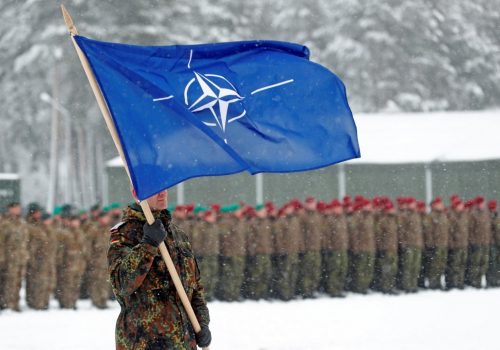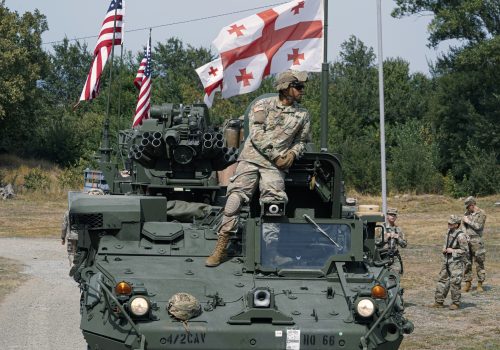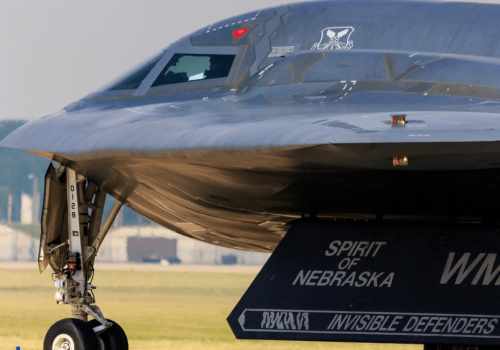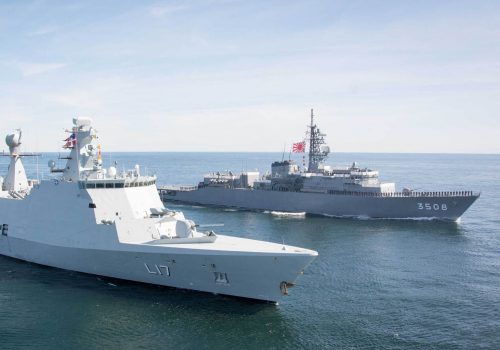Ramp up on Russia
Six years after suspending “business as usual” with Moscow, the Alliance’s Russia policy is largely static and reactive.
NATO has done well in reestablishing deterrence against Russian aggression in the wake of its invasion of Ukraine in 2014. However, in the years since, the Alliance has been less effective at countering Moscow’s ongoing political warfare against NATO members’ societies and democratic values. There is sustained Russian interference in the internal affairs of the NATO member states, little meaningful dialogue in the NATO-Russia Council, an unraveling of arms control constraints, provocative Russian military activities in NATO air and sea space, aggressive disinformation and propaganda campaigns against the West, and unchecked adventurism in the Middle East, Africa, and Afghanistan. Russian-led forces in occupied Donbas continue their attacks on Ukrainian forces and civilians despite numerous ceasefires, a daily reminder of Moscow’s rejection of the Helsinki principles of respect for the sovereignty, independence, and territorial integrity of all European states. Belarus also faces sustained Russian pressure and possible military intervention to suppress the mass protests triggered by the falsified elections in August 2020. And Russia has once again thumbed its nose at the international community by using an illegal chemical weapon to poison opposition leader Alexei Navalny. NATO’s failure to halt Russia’s aggressive behavior puts the future of the liberal international order at risk.
As part of the NATO 2030 initiative, allies need to develop a more dynamic policy toward Russia. The Alliance needs to retake the initiative, increase the costs for Moscow’s disruptive activities, and put real pressure on Russian President Vladimir Putin to change course, while reducing the risk of escalation resulting from Russia’s provocative military behavior.
Putin’s hostility to the West may, in fact, be difficult to diffuse. Relations between the West and Moscow had begun to deteriorate even before Russia’s watershed invasion of Ukraine, driven principally by Moscow’s fear of the encroachment of Western values and their potential to undermine the Putin regime. With the possibility of a further sixteen years of Putin’s rule, most experts believe relations are likely to remain confrontational for years to come. They argue that the best the United States and its allies can do is manage this competition and discourage aggressive actions from Moscow. However, by pushing back against Russia more forcefully in the near and medium term, allies are more likely to eventually convince Moscow to return to compliance with the rules of the liberal international order and to mutually beneficial cooperation as envisaged under the 1997 NATO-Russia Founding Act.
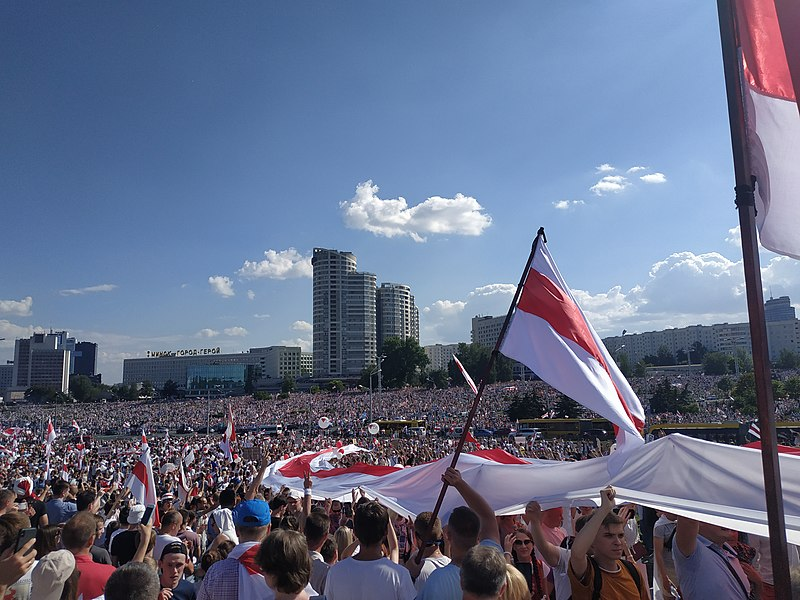
Pushing back against Russia more forcefully in the near and medium term, allies are more likely to eventually convince Moscow to return to compliance with the rules of the liberal international order.
Protests over the recent Presidential election in Belarus continue while Vladimir Putin has expressed a willingness to intervene with Russian security forces.
(Source: Wikimedia Commons)
Strategy toward Russia is admittedly a sensitive subject within the Alliance. Allies have considered it “too hot to handle” since they papered over their differences at the 2016 Warsaw Summit and settled on the current dual-track policy of “defense and dialogue.” This decision was the lowest-common-denominator approach, meant to assuage German, Italian, and other allies’ concerns that NATO was focusing too heavily on military deterrence at the expense of other priorities. Increased dialogue is a noble goal, but it was a strategy without a defined end point. NATO never agreed on what the dialogue was meant to achieve.
This is a debate the Alliance can no longer afford to postpone. Indeed, encouraging difficult debates on issues where NATO strategy is not working will more likely strengthen Alliance solidarity in the long run. Accordingly, launching a review of NATO’s Russia policy should be a priority for 2021. While NATO must also do more to address rising threats from China and Europe’s southern neighborhood, Russia remains the most immediate threat to transatlantic security and deserves top billing on NATO’s agenda for next year.
Raising the costs
If NATO is to turn Putin away from confrontation, the first requirement is to increase the costs to Russia for its aggressive actions. Sanctions imposed since 2014 have not been tough enough to force a real change in Russian behavior. Moscow continues to probe for divisions among allies in the hope that the transatlantic community will grow weary of confrontation and normalize relations. The Kremlin’s latest gambit has been to cite the battle against the coronavirus pandemic as justification for an end to Western sanctions against Russia. To convince Russia that the Alliance will not tolerate aggression and that wedge-driving will not succeed in breaking NATO resolve, allies must push back more aggressively on Russian political warfare.
Key to raising the costs to Russia is a more proactive transatlantic strategy for sanctions against the Russian economy and Putin’s power base, together with other steps to reduce Russian energy leverage and export revenue. A new NATO Russia policy should be pursued in tandem with the European Union (EU), which sets European sanctions policy and faces the same threats from Russian cyberattacks and disinformation. At a minimum, EU sanctions resulting from hostilities in Ukraine should be extended, like the Crimea sanctions, for one year rather than every six months. Better yet, allies and EU members should tighten sanctions further and extend them on an indefinite basis until Russia ends its aggression and takes concrete steps toward de-escalation.
In this regard, allies should consider using sanctions as a deterrent, for example, by spelling out the specific sanctions that would be imposed if Moscow steps up its aggression by attacking the port of Mariupol or illegally seizing Ukrainian ships in the Kerch Strait or Sea of Azov. Allies should be equally specific on what sanctions would be eased if Moscow ends the aggressive activities that led to their imposition.
With respect to defending its own societies, NATO should require that every allied member state strengthen its resilience against cyberattacks, disinformation, and election interference, extending NATO’s traditional remit to these gray-zone threats. While NATO allies may never convince Russia to stop these activities, there is much nations can do to reduce their vulnerabilities, curb the misuse of social media, debunk Russian propaganda in real time, and expose Russian techniques for maintaining plausible deniability. Some of these activities are ongoing, but dedicated resources and a coherent effort with respect to strategic communication from NATO are lacking. In particular, allies should strengthen efforts to engage with the increasingly restive younger generations of Russians—who could someday become advocates of renewed partnership with the West—via radio, television, and social media, as well as traditional exchange programs.
Watch the podcast
Denying spheres of influence
A more dynamic NATO strategy for Russia should go hand in hand with a more proactive policy toward Ukraine and Georgia in the framework of an enhanced Black Sea strategy. The goal should be to boost both partners’ deterrence capacity and reduce Moscow’s ability to undermine their sovereignty even as NATO membership remains on the back burner for the time being.
As part of this expanded effort, European allies should do more to bolster Ukraine and Georgia’s ground, air, and naval capabilities, complementing the United States’ and Canada’s efforts that began in 2014. NATO should also step up its support for domestic defense reforms and efforts to meet NATO interoperability standards, together with programs to reinforce their resilience against cyberattacks. To underscore the durability of NATO’s commitment, the Alliance should establish a permanent military presence at Ukrainian and Georgian training centers close to Russian-occupied territories. At a minimum, NATO should hold more frequent exercises on both countries’ respective territories and in the Black Sea to counter Russia’s military build-up since the illegal annexation of Crimea.
On the information front, Putin has been increasingly successful in suppressing information about combat casualties among Russian “volunteers” fighting in Donbas and the economic costs of propping up the occupation regimes in Donbas and Crimea. To raise the domestic political costs to Putin and increase the pressure for a negotiated end to the war, NATO should use open-source and declassified intelligence more strategically to refocus the spotlight on Russia’s brutality and reign of terror in Donbas. NATO should also work more closely with Ukraine to debunk Russian propaganda that falsely portrays Ukraine as a right-wing failed state and to connect with Russian-speaking audiences in the occupied territories and Russia itself through social media, online media, and other channels.
In Belarus, where the opposition does not seek NATO or EU integration, the Alliance needs to walk a fine line: opposing violence and encouraging political dialogue—perhaps mediated by the Organization for Security and Cooperation in Europe (OSCE)—that could lead to early new elections and a change in government without giving Moscow a pretext for military intervention. If Moscow does use force, however, allies will need to consider new sanctions as well as consider adjustments to NATO’s force posture in the Baltic region.
Beyond Europe, under renewed US leadership, NATO should work to forge a unified response to Russian adventurism in the Middle East and North Africa. Libya is the place to start. A new effort by allies to broker a political compromise between the United Nations (UN)-recognized government in Tripoli and General Khalifa Haftar’s forces in the East could deny Russia a new strategic foothold in the Eastern Mediterranean and open the way to a negotiated end to Libya’s civil war. It would also offer a way to get Turkey back on the same page with the rest of the Alliance and curtail Turkish President Recep Tayyip Erdoğan’s rapprochement with Putin.
Using dialogue to reduce risks
There are several steps that the United States and its allies could take toward reducing risks posed by Russia and building a more stable relationship with Moscow, despite the underlying strategic competition. In the realm of security, allies could look at the Cold War toolbox—namely arms control and confidence-building measures—for ways to increase transparency and predictability while lowering the risk of unintended conflict. The aim should be to give substance to the dialogue half of NATO’s two-track strategy of defense and dialogue.
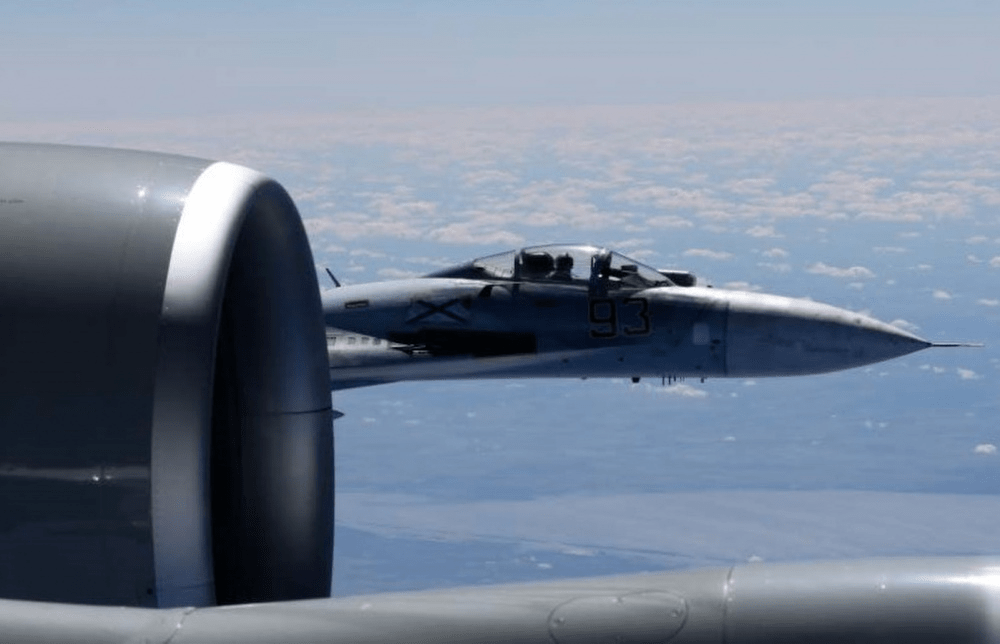
The aim should be to give substance to the dialogue half of NATO’s two-track strategy of defense and dialogue.
A US RC-135U flying in international airspace over the Baltic Sea was intercepted by a Russian SU-27 Flanker June 19, 2017. Due to the high rate of closure speed and poor control of the aircraft during the intercept, this interaction was determined to be unsafe.
(Photo by Master Sgt. Charles Larkin Sr, US European Command)
Though Moscow has so far rebuffed the idea, NATO should challenge Russia to adopt the allies’ proposals for strengthening the OSCE Vienna Document. These include lower thresholds for notifications and inspections of exercises, a cap on the aggregate size of exercises in proximity to the NATO-Russia border, and a ban or low quota on no-notice “snap” exercises, to name a few. These steps could be accompanied by reciprocal political commitments to reduce the frequency of aggressive air operations close to each other’s airspace. Allies and Russia could also agree to multilateralize bilateral US-Russian agreements on the prevention of Incidents at Sea and Dangerous Military Activities—both of which could ensure real-time, military-to-military communications amid a crisis.
NATO could go further and offer to renew the military-to-military dialogue in the OSCE and NATO-Russia Council. The Alliance could make clear this measure does not constitute a full return to business as usual, but rather a move needed to minimize misperceptions about each side’s military activities and promote agreement on new risk-reduction measures. It would also offer a way to increase both sides’ understanding of the implications of new weapons technologies and artificial intelligence before they have fundamentally changed the nature of war.
On the nuclear side, NATO allies should encourage the United States and Russia to preserve the New Strategic Arms Reduction Treaty (START) for at least another one to two years, which would buy time to negotiate a new, broader agreement encompassing non-strategic nuclear weapons and the forces of other nuclear powers. As part of an extension, both sides should make a binding political commitment that new weapons like hypersonic missiles and Russia’s nuclear-powered drones will be subject to New START limits while they work on a longer-term agreement.
While the Intermediate-Range Nuclear Forces (INF) Treaty cannot be brought back from the dead, allies and Russia could agree that neither side will introduce nuclear-armed cruise or ballistic missiles in Europe and, in Russia’s case, that it will remove from Europe any nuclear-armed versions of its 9M729 missile that precipitated the demise of the INF Treaty. The intrusive measures needed to verify these commitments could be part of the follow-on agreement to New START.
At the same time, the United States and Russia should continue strategic stability talks and try to work more closely together on non-proliferation (in particular, denuclearization of North Korea) and the fight against terrorism—both areas where Moscow’s and Washington’s interests still overlap.
To restore partnership, Ukraine is the litmus test
Raising the costs for Russian aggression and reducing the risks of military conflict may be the most that the United States and its allies can achieve in the short term. NATO allies should make clear, however, that their longer-term vision remains a return to the path of cooperation and partnership that NATO and Russia pursued—to mutual benefit—in the immediate post-Cold War decades. However, this can only happen when Russia is willing to recommit—in deed as well as word—to the basic principles of Euro-Atlantic security that have guided all NATO nations in the past, and which Moscow previously pledged to uphold as well.
The longer-term vision remains a return to the path of cooperation and partnership that NATO and Russia pursued—to mutual benefit—in the immediate post-Cold War decades. However, this can only happen when Russia is willing to recommit—in deed as well as word—to the basic principles of Euro-Atlantic security that have guided all NATO nations in the past.
The essential first step and litmus test would be for Moscow to work with Ukraine and its international partners to find a durable solution to the conflict in Donbas, based on full implementation of the Minsk agreements. While NATO has thus far not been directly engaged in Minsk diplomacy, it could support the process by assisting non-NATO countries in setting up an international peacekeeping force (potentially under the authority of the UN Security Council or OSCE) to establish and oversee the implementation of the Minsk accords, to include holding free and fair local elections under Ukrainian law in the now-occupied Donbas. Although NATO and Russia would not be part of the peacekeeping force, the NATO-Russia Council could be the venue for discussing the parameters of the force and lining up troop contributors from among NATO’s partners.
To encourage Moscow to get serious about ending its undeclared war in Eastern Ukraine, allies could signal a readiness to negotiate a new Code of Conduct for European security in tandem with the lifting of sanctions that would follow the implementation of Minsk. That agreement could take the form of an update to the NATO-Russia Founding Act, and would enter into force when Russia had fully withdrawn its forces and proxies from Donbas. While returning Crimea to Ukraine would remain a long-term challenge, a just settlement in Donbas would enable the sides to turn the page and begin to rebuild NATO-Russia cooperation.
* * *
Ambassador Alexander Vershbow is a distinguished fellow in the Atlantic Council’s Scowcroft Center for Strategy and Security. He is a former NATO deputy secretary general, assistant secretary of defense, and ambassador to NATO, Russia, and the Republic of Korea
Explore the podcast series
Related NATO 20/2020 essays
Related program

The Transatlantic Security Initiative, in the Scowcroft Center for Strategy and Security, shapes and influences the debate on the greatest security challenges facing the North Atlantic Alliance and its key partners.
Subscribe for events and publications on transatlantic security
Sign up for updates from the Atlantic Council’s Transatlantic Security Initiative, covering the debate on the greatest security challenges facing the North Atlantic Alliance and its key partners.
Image: NATO’s Supreme Allied Commander Europe meets with General Valery Gerasimov, Chief of the General Staff of the Armed Forces of the Russian Federation.
